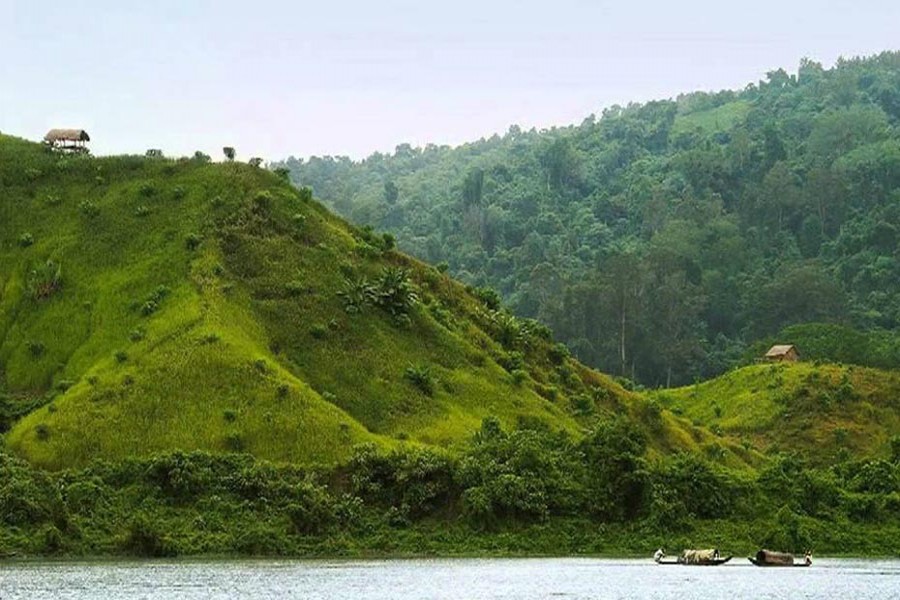After afflicting the greater Chattogram region, the menace of hill-cutting has lately spread to the greater Sylhet -- especially Moulvibazar district. Many other areas in the country are fast becoming vulnerable to the grabbers of hills. The Chattogram Hill Tracts, Cox's Bazar and the suburbs of the port city have been facing the reckless hill-cutting since long. Syndicates of local influential people in collusion with corrupt elements in the administration are allegedly involved in this vile act; the fact emerges a stark reality for the country.
Following decades of unabated hill-cutting, or hill-levelling, almost all the hilly areas in Bangladesh now wears a changed look. With the tree covered hills gone, the vacant areas now have housing complexes and business establishments and other infrastructure in place. These ventures are passed off as so-called development works. On the other hand, whatever small stretches of hills the plain-land country found within its borders after the 1947 Partition are fast passing into memory. So is the natural beauty these hills offer to the aesthetically disposed tourists. Many of them have already started becoming disillusioned finding the hills vanished.
Like in many others, this country also has a stringent segment in its Environment Preservation Act 1995, amended in 2000. It prohibits cutting of hills without approval of the authorities concerned. There are provisions of punishment for the offence. Punishment for hill cutting is imprisonment for up to two years, or fine of Tk 200 thousand or both for a first-time offence. For the later acts of law-breaking, the punishment gets severe with up to 10 years imprisonment or fine of Tk 1.0 million or both. In the prevalent culture of lax surveillance and impunity, these punishments are, indeed, stringent. In a recent case, the district administration of Moulvibazar fined three persons for hill levelling. The irony is the compulsive and powerful offenders seem not to care a fig for these punitive measures. They continue to remain engaged in this despicable act, with little regard for the relevant laws. Upon striking collusion with dishonest elements in the local administration, these people manage to get away with their offences. Incidents of bringing them to the legal dragnet are few and far between.
Apart from changing the geophysical shape of the country, the hill-cutting menace brings with it scores of dire consequences. Prominent among them is the catastrophe of landslide which visits the country in almost every monsoon. Since most of the country's large hills are located in Chattogram, Cox's Bazar and the three hill districts, these have for decades been ravaged by landslides. Lately, the defiant hill-levellers have started making inroads into the hill districts, especially Rangamati. These acts are resulting in massive landslides. The largely man-made disasters have claimed hundreds of lives in the recent years. Owing to dearth of dwellings and shelters, the poverty-stricken people have long chosen the hills as ideal spots for living. Cutting of hills was largely an absurd idea to these regions. Small-scale hill cutting did not have much impact on the core structure of the hills. But the start of taking away chunks of the hills and later causing large-scale damage to them made these hills hazardous for living.
In spite of repeated landslides in the hills of all these districts resulting in casualties, the trend of setting up slums there could not be stopped -- especially in the port city. The authorities concerned in the case of these disasters put in the best of their efforts to dissuade people from settling on the precarious slopes of hills. Although desperation and defiance on the part of the poor has largely been blamed for their fateful return to those death-traps after eviction, the role of the local villains cannot be overlooked. The administration finds itself helpless before the apparently invincible syndicates renting out shanty-based settlements on hills. These elements have yet to be effectively prevented from beckoning the homeless people to the hazard-filled slopes of hills.
That of all places, it is the greater Chattogram region which needs strict enforcement of Bangladesh Environment Preservation Act is no exaggeration. The region has the largest segment of the country's hilly terrains. On top of all, the three districts of the country's lone hill tracts region are located in this area. The country's required level of biodiversity depends to a great extent on its trees grown in the hill tracts. Moreover, these hills have amply proven a strong bulwark against cyclones that assault Bangladesh frequently. Given these points, the country can drag its feet on the task of protecting its hills at its peril. The speed at which hills are being levelled in the country portends ominous times. The most dreadful impact of the feared scenario without hills would be the irreparable loss to the country's biodiversity. The impact on the overall environment might appear to be colossal. In order to ensure that a foolproof and effective hill saving act remains in force with strict application and the nation is spared the fallout of biodiversity loss, work must begin without any inordinate delay. Protection of hills ought to be included in all programmes, which comprise the national visions for the future.


